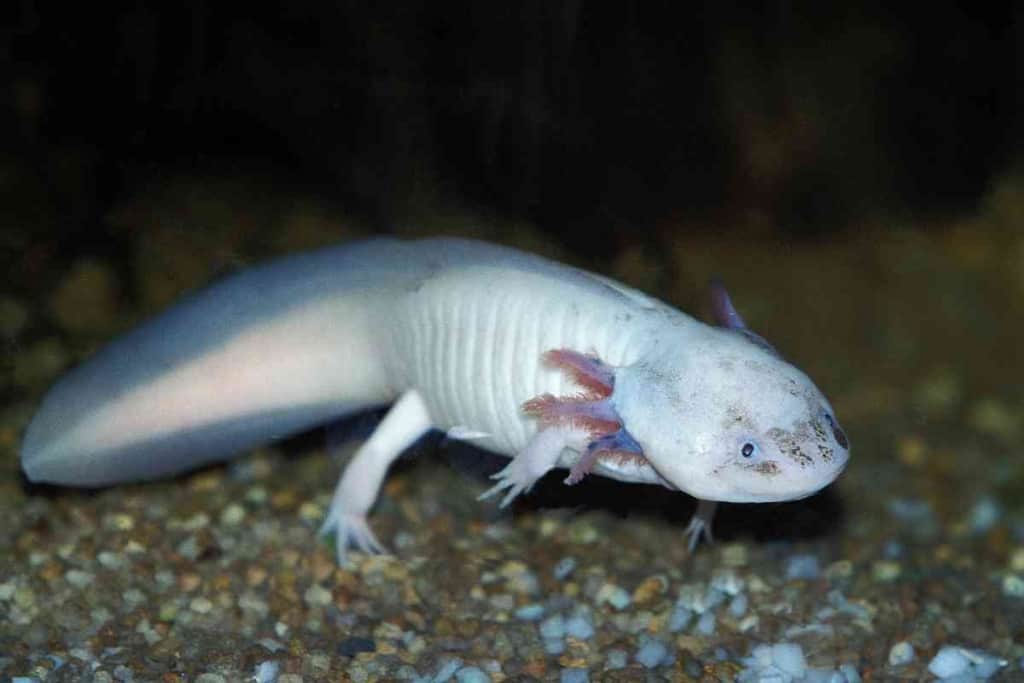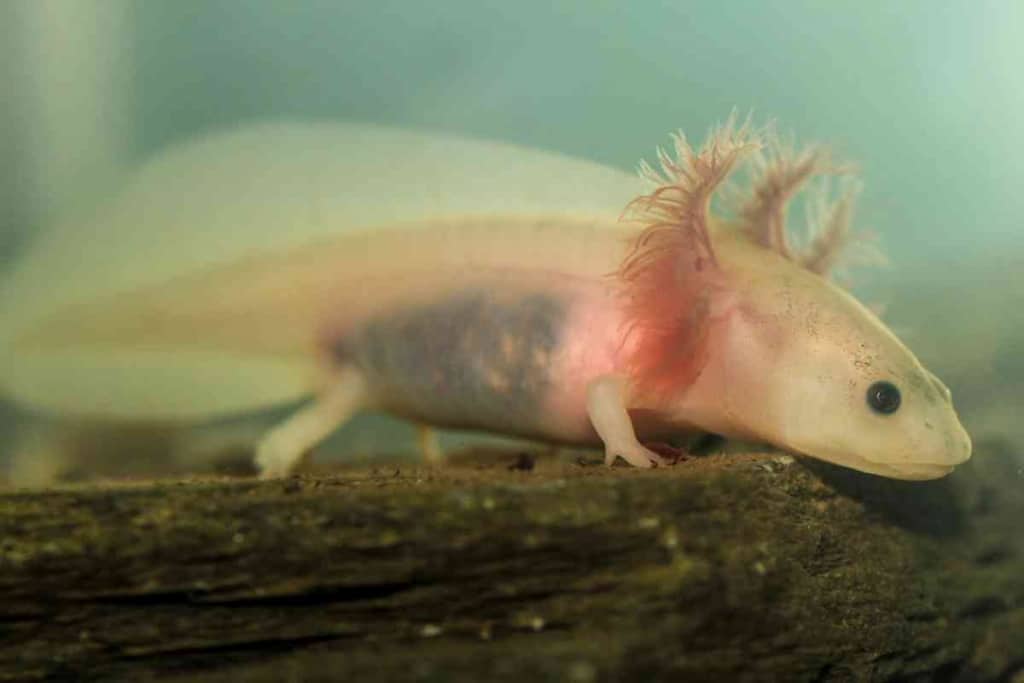Why Is My Axolotl So Skinny? An Axolotl Weight Guide
You may have noticed that your axolotl is looking a bit thinner than usual. There can be many reasons for this.
If your axolotl is skinny, it may be because it isn’t getting enough food. Your axolotl may also be stressed in the presence of other creatures. Another reason for being skinny is that your axolotl may be suffering from a disease.
As an owner of many axolotls, I have had a lot of experience in caring for them. I have been an axolotl enthusiast all my life and have conducted several interviews with expert veterinarians on how to best care for them.
How to Check If Your Axolotl Is Too Skinny

First of all, it is important to note that axolotls come in a variety of shapes and sizes. So, what may be considered “skinny” for one axolotl may be completely normal for another.
With that said, there are still some general things you can look for to determine if your axolotl is too skinny.
One way to check if your axolotl is too skinny is to look at its body.
If the body appears to be thinner than usual, this may also be a sign that your axolotl is not getting enough food. A healthy axolotl has a belly equal or larger than its head.
If the belly is significantly smaller than the head, this may be a sign that your axolotl is not getting enough to eat.
Another way to determine if your axolotl is too skinny is to look at its skin. Healthy axolotls have smooth, shiny skin.
If the skin appears dull and dry, this may be a sign of malnutrition. Additionally, if you notice any red or white patches on the skin, this could also be a sign of a health problem.
Finally, you can also try gently pressing on your axolotl’s body.
If you can feel its ribs or backbone easily, this may be a sign that your axolotl is too skinny.
If you are concerned that your axolotl may be too skinny, it is always best to consult with a veterinarian who is familiar with these pets.
What Causes an Axolotl to Become Skinny?
There are a variety of reasons why an axolotl may become skinny. One possibility is that the axolotl is not getting enough food.
If you are feeding your axolotl live food, it is possible that the prey is simply too fast for the axolotl to catch.
In this case, you may want to try switching to a slower-moving food source, such as frozen or freeze-dried shrimp or worms.
Another possibility is that the axolotl is not digesting its food properly. This can be a result of a number of different things, including stress, parasites, or a poor diet.
If you think this may be the case, it is best to consult with a veterinarian who can help you determine the cause and find a solution.
Finally, it is also possible that the axolotl is sick. If your axolotl has any other symptoms in addition to being skinny, such as lethargy, loss of appetite, or strange behavior, it is best to take it to a vet for an examination.

Why Is My Axolotl Not Eating?
If your axolotl is not eating, this could be a sign that it is sick. However, there are a number of other possible reasons why an axolotl may lose its appetite.
One possibility is that the water in the tank is too cold. Axolotls are tropical animals, and they prefer water that is around 68-72 degrees Fahrenheit.
If the water in the tank is cooler than this, it may cause the axolotl to become sluggish and lose its appetite.
Another possibility is that the water in the tank is too dirty. Ammonia and nitrites can be toxic to axolotls, so it is important to keep the tank clean.
If you think the water quality may be the problem, it is best to test it with a water quality test kit and make sure the levels are within the safe range.
If you have recently added new fish or other animals to the tank, this could also be stressful for the axolotl and cause it to lose its appetite. In this case, it is best to remove the new addition and see if the axolotl’s appetite improves.
Finally, it is also possible that there is something wrong with the food you are feeding. If you are feeding live food, it is possible that the prey is too fast for the axolotl to catch.
In this case, you may want to try switching to a slower-moving food source, such as frozen or freeze-dried shrimp or worms.
Skinny Axolotl Symptoms
There are several symptoms indicating your axolotl is quite skinny. Common signs include loss of appetite, inactivity, a smaller stomach, and listlessly floating.
If the main problem is the loss of appetite, you need to find the reason why.
You should try enticing it with its preferred food by holding it in front of them or luring it closer with food on a stick. By doing this, you can determine if they are simply not hungry or if there is something else wrong.
Other skinny axolotl symptoms include inactivity and listlessly floating. This could be due to the water being too cold for them since they are tropical animals.
As mentioned above, the recommended temperature for axolotls is 68-72 degrees Fahrenheit. If the water is colder than this, it will make them sluggish and possibly lose their appetite as well.
Skinny Axolotl Treatment
If your axolotl is skinny, the first thing you should do is try to determine the cause.
If you think the problem may be a lack of food, try switching to a slower-moving food source, such as frozen or freeze-dried shrimp or worms.
You can also try force-feeding your axolotls by filling up a syringe with moist food and inserting it in the mouth. You will first have to put it in a quarantine tank having better water quality.
Another possibility is that the axolotl is not digesting its food properly.
This can be a result of a number of different things, including stress, parasites, or a poor diet.
Finally, if you think the problem may be stress, try removing any new fish or other animals from the tank. This will help reduce the stress on your axolotl and possibly improve its appetite.
When to See a Vet

If your axolotl has any other symptoms in addition to being skinny, such as lethargy, loss of appetite, or strange behavior, it is best to take it to a vet for an examination.
Your vet will likely perform a physical examination and order some lab tests.
They may also recommend X-rays or an ultrasound to get a better look at the inside of the axolotl’s body.
Based on the results of the examination and tests, your vet will be able to determine if there is an underlying health condition causing the weight loss.
They will then give you recommendations on how to treat the condition and help your axolotl gain weight.
Common Diseases in Axolotls
There are several diseases that can cause weight loss in axolotls. Some of the most common include.
● Metabolic bone disease – This is a common condition in captive axolotls that results in softening of the bones. It is often caused by a lack of calcium or vitamin D3 in the diet.
● Kidney disease – This is another common health problem in axolotls and can be caused by a number of different things, including genetic defects, infections, stress, and toxins.
● Parasites – Intestinal parasites are also fairly common in axolotls and can cause weight loss as well as other problems, such as diarrhea.
If you think your axolotl may be ill, it is important to take it to a vet for an examination. They will be able to determine if there is an underlying health condition causing the weight loss and give you recommendations on how to treat it.
Key Takeaways
- Your axolotl may be skinny if it isn’t getting enough food or isn’t feeling well.
- If your axolotl isn’t feeling well, it will show a lack of appetite, a smaller stomach or inactivity.
- You can treat your axolotl by force-feeding it or removing all the stress triggers in its environment
